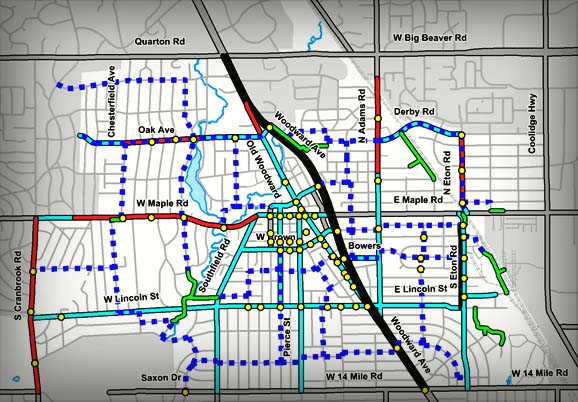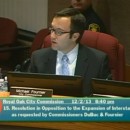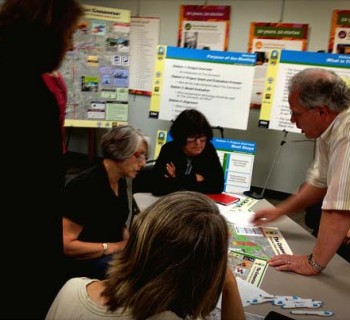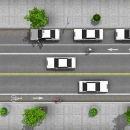BIRMINGHAM, Mich.—The suburban Detroit community of Birmingham has given a thumbs up to a new multimodal transportation plan that promotes improved infrastructure for bicyclists, pedestrians and other road users.
Birmingham's city commission voted unanimously Nov. 25 to receive the plan and directed city workers to begin implementing policies and programs it recommends that don't require any budgetary amendments. This means city workers can use the multimodal plan as a guide to public transportation projects, though they will have to conduct additional corridor and traffic studies before making any physical changes to the road system.
Mayor Scott Moore told Mode Shift the commission is excited to be moving forward with the effort.
"We've always taken pride that we're a walkable city, and this only will enhance that brand and will enhance quality of life for community residents [and] for all users of our streets," he said. "Essentially, it's going to improve quality of life and it's where our culture is headed."
A special city-designated committee spearheaded the plan with assistance from The Greenway Collaborative, an Ann Arbor-based consulting firm. It's been in the works for a-year-and-a-half and builds off a 2011 resolution supporting Complete Streets policy, which holds that new road projects be designed with all users in mind.
Among other things, the plan suggests:
- Reducing the number of motor vehicle lanes on Maple Avenue between Lake Park Drive and Chesterfield Avenue and on Oakland Avenue near Park Avenue.
- Retrofitting non-ADA-compliant curbs around the city with proper ramps.
- Developing a walking and biking map to be distributed for free to Birmingham residents.
- Filling in gaps in the cities sidewalk system.
- Creating curb extensions that move sidewalks closer to the street, shortening the distance pedestrians have to walk.
- Making crossways safer with features like high visibility markings, flashing signals and crossing islands.
- Establishing pedestrian-and-bicycle wayfinding markers.
- Creating bike corridors and greenways and installing regular and buffered bike lanes.
- Putting amenities at transit facilities like a concrete pad wheelchair users can rest on while waiting for a ride.
Birmingham's multimodal plan was developed through a process that included a web survey, two public open houses, a nine-mile bike tour and a two-mile walking tour.
Reducing accidents involving cyclists and pedestrians is one of the city commission's main objectives for looking into multi-modal infrastructure enhancements. According to a draft of the plan featured on The Greenway Collaborative's website, motor vehicles hit 67 pedestrians and 44 bicyclists between 2004 and 2011, an average of about one per month.
Other reasons include attracting a younger more educated demographic to the city, encouraging residents to get fit by engaging in more physical activity, and creating safer streets for the city's aging population.
Mayor Moore told Mode Shift a current road project on Lincoln Avenue is already making use of multimodal principles.
That project, which will feature bike lanes, should be completed next spring, but Moore believes a fuller realization of the program won't be evident for at least a generation.
"For the most part this is a long range plan and it will be implemented over the next many, many years," he said. "[It] will be implemented over the next generation, as streets are improved and resurfaced the principles of the plan will be implemented."
Read a draft of Birmingham's multimodal plan.
Like what you see here? Contact your local government officials and share your thoughts about Complete Streets and multimodal planning principles.










